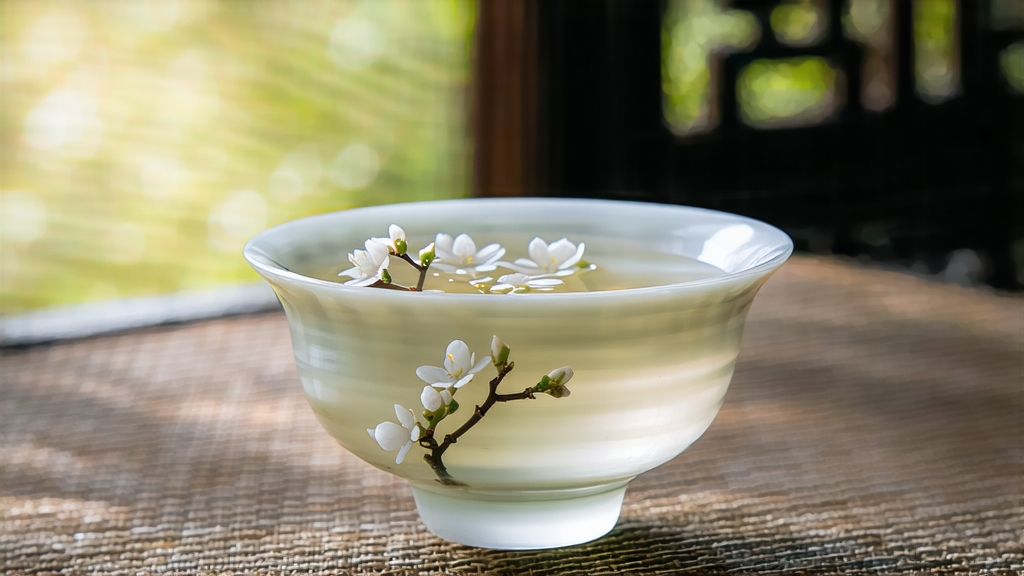
White tea, the least disturbed of all China’s six great tea families, is often praised for its “two needles and one leaf” trio—Silver Needle, White Peony, and Shou Mei. Among them, Silver Needle (Bai Hao Yin Zhen) stands like a solitary moonbeam: rare, luminous, and insistently subtle. To understand Chinese white tea, one must begin with this single-bud aristocrat that once traveled the Silk Road as a medicinal tribute and now graces the cupping tables of Oslo, Melbourne, and Vancouver. This essay invites the international reader into the world of Silver Needle—its birth in coastal Fujian, its minimalist craft, its quiet brewing ritual, and the contemplative language through which professionals evaluate its fleeting flavors.
-
Historical silhouette
Song-dynasty scrolls already record “white tablets” pressed for the emperor, but the first unmistakable description of loose, all-bud white tea appears in the 1796 Jiaqing-era gazette of Fuding County. Local officials offered “needle-shaped buds covered in hoarfrost” to the imperial court, believing their cooling property could quell summer heat and palace fevers. When British plant hunter Robert Fortune passed through Fuding in 1851 he noted “a peculiar pale tea with silky hairs,” shipping a small chest to London where it was auctioned as “Pekoe Souchong Buds.” Thus Silver Needle entered global consciousness as both botanical curiosity and luxury drug. Republican-era (1912-1949) tea merchants in Hong Kong aged the buds in clay jars, advertising them as “diminutive ginseng,” while 1970s Japanese researchers isolated the high flavonoid content that would later fuel white-tea skincare trends. Today, protected geographical indication (PGI) status limits authentic Silver Needle to the coastal terroirs of Fuding and Zhenghe in northern Fujian, where subtropical humidity, red granitic soils, and marine fog create the biochemical magic that coats each bud in a silver duvet of trichomes. -
Terroir and harvest calendar
Authentic Silver Needle is plucked only in early spring, typically between 15 March and 10 April, when the air is still too cool for insects, eliminating the need for pesticides. Growers rise before dawn to pick the unopened “chicken-tongue” bud just as the first ray of sun touches the tea garden; the dew acts as a natural antioxidant buffer during the long withering hours that follow. Each kilo of finished tea demands roughly 30,000 buds, all hand-selected for uniform length (2.5–3 cm) and a subtle blush at the tip known as “little red hearts.” The highest grade, “North Mountain Silver Needle,” originates from the misty slopes of Taimu Mountain at 600–800 m, where diurnal temperature swings slow respiration and concentrate amino acids, yielding a sweeter, more umami-laden cup. -
The craft of “non-craft”
White tea’s philosophy is wu wei—effortless action. Once picked, the buds are laid upon bamboo sieves in an airy pavilion where mountain cross-breezes, soft sunlight, and time perform the transformation. No pan-firing, no rolling, no roasting; only the slow withdrawal of moisture. Master withers speak of “three reds and seven whites,” meaning the bud should acquire a faint salmon hue on 30 % of its surface while retaining a downy pallor elsewhere. Over-withering produces a straw-like emptiness; under-withering traps grassy volatiles that mask the signature honeydew note. When the moisture drops to 8–10 %, the buds are gently charcoal-baked at 40 °C for twenty minutes—a nod to modern food-safety standards—then rested for at least a month so that residual enzymes mellow. The entire cycle respects the Daoist adage: “Man follows earth, earth follows sky, sky follows Dao, Dao follows nature.” -
Grading lexicon for the global buyer
International wholesalers often encounter cryptic labels: “King Grade,” “Special,” or simply “AAA.” A more reliable guide is the China National Standard GB/T 22291-2017, which classifies Silver Needle into two tiers—Special Grade and First Grade—based on bud plumpness, trichome density, and presence of red tips. Specialty importers add a third, unofficial tier, “Estate Micro-lot,”